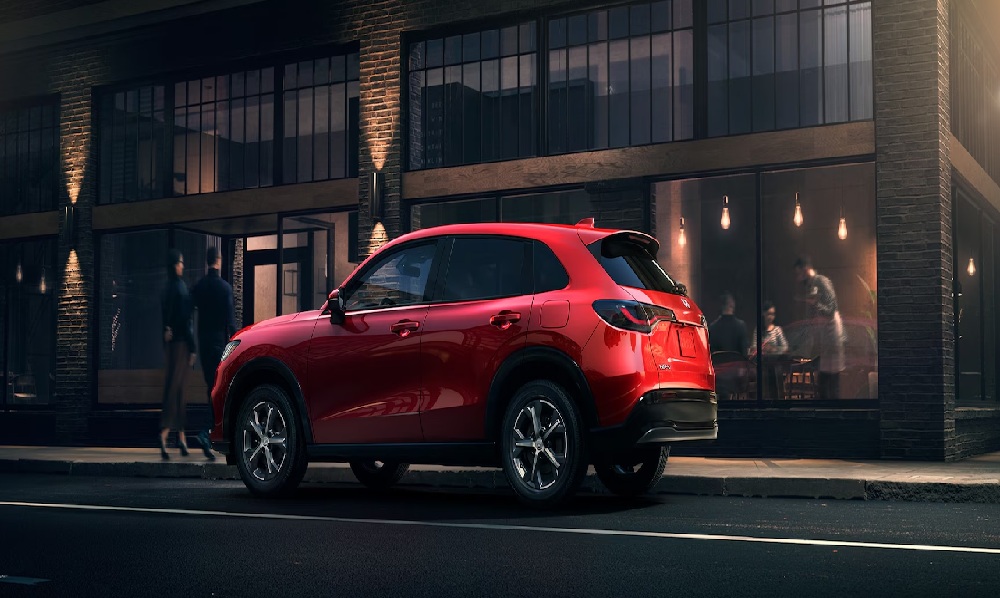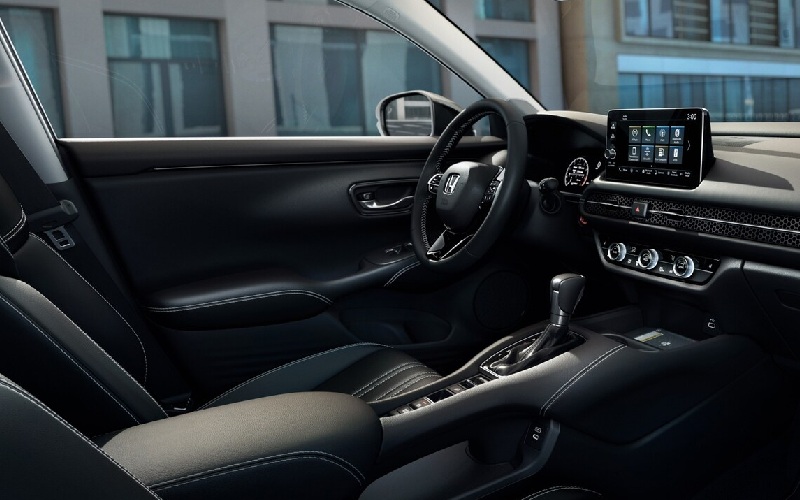The Honda HR-V continues to establish itself as a compelling option in the competitive subcompact crossover segment, offering a blend of versatility, efficiency, and reliability that resonates with Canadian drivers. At the heart of the HR-V driving experience lies its transmission system—a critical component that significantly influences everything from fuel economy to driving dynamics.

Continuously Variable Technology
Honda equips all HR-V trim levels for the latest model year with a Continuously Variable Transmission (CVT). Honda refers to this implementation as an M-CVT, representing the “Modified” or “Modern” evolution of continuously variable transmission technology. This single transmission offering across the lineup represents Honda confidence in the CVT ability to deliver an optimal balance of efficiency, performance, and refinement.
The HR-V transmission system functions fundamentally differently from conventional automatic transmissions. Rather than utilizing fixed gear ratios, the CVT employs a pair of variable-diameter pulleys connected by a metal belt or chain. This arrangement allows for infinitely variable gear ratios within its operating range, enabling the engine to maintain its optimal RPM for maximum efficiency or power, depending on driving conditions and throttle input.
Technical Specifications
The HR-V CVT offers impressive technical specifications that optimize the vehicle’s performance:
- Ratio Range: 2.526~0.408
- Reverse Ratio: 2.706~1.552
- Final Drive Ratio: 5.436
- Transmission Type: Belt-driven continuously variable transmission
- Control System: Electronic shift-by-wire with Sport Mode
- Special Feature: G-Design shift logic
These specifications allow for an exceptionally wide ratio spread of approximately 6.2:1, exceeding many conventional automatic transmissions and enabling both responsive acceleration and efficient highway cruising.
G-Design Shift: CVT Drive Dynamics
A common criticism of CVT technology has historically been the “rubber band effect”—a sensation where engine RPM increases dramatically. At the same time, vehicle speed catches up more gradually, creating a disconnected driving feel. Honda has directly addressed this concern in the HR-V transmission through its innovative G-Design Shift technology.
The G-Design Shift programming creates a more natural acceleration sensation by simulating discrete “shift points” similar to a traditional automatic transmission. Rather than holding a constant RPM during acceleration, the system allows engine speed to rise and fall in a pattern that feels more familiar and engaging to drivers accustomed to conventional transmissions.
This technology provides several tangible benefits:
- Reduced engine drone during acceleration
- More intuitive connection between throttle input and vehicle response
- Enhanced feeling of positive acceleration
- Greater driver confidence during passing maneuvers
- Improved NVH (Noise, Vibration, Harshness) characteristics
The G-Design Shift logic is particularly valuable when merging onto Canadian highways or navigating the varying elevations found in regions like British Columbia’s Lower Mainland or the rolling terrain of Quebec’s Laurentians.
Sport Mode: Enhanced Driving Engagement
Complementing the CVT efficiency-focused operation is a dedicated Sport Mode, activated via the electronic shift-by-wire system. When engaged, this mode alters several transmission parameters to deliver a more responsive driving experience:
- Maintains higher engine RPM for improved throttle response
- Simulates more aggressive “downshifts” during deceleration
- Holds lower ratios longer during cornering
- Provides enhanced engine braking
- Responds more quickly to throttle inputs
For drivers navigating the twisting roads of coastal Nova Scotia or the mountain passes of Alberta, Sport Mode transforms the HR-V character from efficient commuter to surprisingly engaging crossover. The mode is easily accessible through the shift lever, allowing drivers to adapt the vehicle’s character to changing road conditions or driving preferences.
Integration with Drive Modes
The HR-V features a 3-mode drive system that works with the CVT to adapt to various driving scenarios. The three available modes—Econ, Normal, and Snow—each alter the transmission’s behaviour in conjunction with other vehicle systems:
ECON Mode:
- Earlier upshifts to maximize fuel efficiency
- More gradual throttle mapping
- Reduced climate control system operation
- Ideal for urban driving in cities like Toronto or Montreal
Normal Mode:
- Balanced operation for everyday driving
- Standard throttle response and shift patterns
- Default setting for optimal all-around performance
- Well-suited to mixed driving conditions across Canadian provinces
Snow Mode:
- Starts in a higher ratio to reduce torque and prevent wheelspin
- Maintains higher ratios during acceleration on slippery surfaces
- More conservative throttle mapping
- Essential for winter driving across Canada, from Vancouver’s wet snow to Quebec’s deep powder
This integrated approach ensures the CVT operation complements other vehicle systems to deliver consistent performance across varying conditions—a particularly valuable feature given Canada’s dramatic seasonal variations.
Performance Metrics and Efficiency
The HR-V CVT plays a crucial role in balancing performance and efficiency:
Acceleration Characteristics
When paired with the HR-V 2.0-liter naturally-aspirated four-cylinder engine (producing 158 horsepower at 6,500 rpm and 138 Nm of torque at 4,200 rpm), the CVT helps deliver:
- 0-100 km/h Acceleration: Approximately 9.7-10.2 seconds (depending on drivetrain)
- 80-120 km/h Passing Acceleration: Approximately 7.8 seconds
- Standing Start to 400 meters: Approximately 17.2 seconds
These figures position the HR-V competitively within its segment, offering sufficient performance for confident highway merging and passing maneuvers on Trans-Canada Highway routes.
Fuel Efficiency
The CVT ability to maintain optimal engine RPM significantly contributes to the HR-V impressive fuel economy ratings:
- Front-Wheel Drive Models:
- City: 10.9 L/100 km
- Highway: 7.3 L/100 km
- Combined: 9.4 L/100 km
- All-Wheel Drive Models:
- City: 11.3 L/100 km
- Highway: 7.8 L/100 km
- Combined: 9.8 L/100 km
These efficiency figures make the HR-V an economical choice for both urban commuting and longer highway journeys, such as drives between Toronto and Ottawa or Vancouver to Kelowna.
Drivetrain Integration: FWD and AWD Applications
The HR-V offers two drivetrain configurations, each working harmoniously with the CVT but offering distinct characteristics:
Front-Wheel Drive
The base configuration pairs the CVT with a front-wheel-drive system emphasizing efficiency and value. Key characteristics include:
- Lighter overall weight (approximately 117 kg less than AWD models)
- Superior fuel economy
- Simplified mechanical design
- Excellent traction in most normal driving conditions
- Ideal for urban drivers in milder climate regions
Real Time AWD with Intelligent Control System™
Higher trim levels come equipped with the Honda Real Time AWD system, which works in concert with the CVT to provide:
- On-demand torque transfer to rear wheels when slippage is detected
- Proactive engagement during acceleration to reduce torque steer
- Enhanced stability during inclement weather conditions
- Improved handling on varying surfaces
- Up to 40% of available torque sent to the rear axle when needed
The integration between the CVT and AWD system is seamless, with the transmission adapting its behaviour based on AWD engagement. During slippery conditions, the CVT adjusts its ratio selection to complement the AWD system’s torque distribution, resulting in optimized traction without driver intervention.
This AWD capability makes the HR-V particularly well-suited to Canadian driving conditions, from the snowy urban streets of Montreal to the gravel cottage roads of Ontario’s Muskoka region.
Transmission Durability and Maintenance
Honda has engineered the HR-V CVT for long-term reliability in Canadian operating conditions:
Cold Weather Performance
The transmission includes several features specifically designed for cold-climate operation:
- Enhanced fluid circulation for quicker warm-up in sub-zero temperatures
- Optimized cold-start programming to reduce strain on components
- Temperature-adaptive pressure control
- Special transmission fluid formulation for consistent performance across temperature extremes
These features are particularly valuable in provinces like Manitoba, Saskatchewan, and Alberta, where winter temperatures regularly drop well below -20°C.
Maintenance Requirements
Honda recommends the following maintenance schedule for the HR-V CVT:
- Transmission Fluid Change: Every 48,000 kilometers under normal conditions
- Fluid Capacity: Approximately 3.7 liters for a complete change
- Recommended Fluid: Honda HCF-2 Continuously Variable Transmission Fluid
- Inspection Interval: Every 24,000 kilometers for signs of leakage or unusual noise
Following this maintenance schedule helps ensure optimal transmission performance throughout the vehicle’s lifespan, even under demanding Canadian driving conditions.
Canadian Driving Experience
The HR-V CVT is particularly well-suited to several Canadian driving scenarios:
Urban Commuting
In congested urban centers like Toronto, Vancouver, and Montreal, the CVT offers:
- Smooth stop-and-go operation without the hunting between gears experienced with conventional automatics
- Improved fuel efficiency in city traffic
- Reduced driver fatigue through elimination of shift shock
- Quick response when gaps in traffic present passing opportunities
Highway Travel
For longer journeys on Canada’s expansive highway network, the transmission provides:
- Optimized cruising efficiency by maintaining ideal engine RPM
- Immediate ratio adjustments when encountering hills or passing situations
- Reduced engine noise during steady-state cruising
- Consistent performance across varying elevations
Winter Conditions
During Canada’s challenging winter months, the CVT contributes to safer operation through:
- Smooth power delivery that reduces the risk of wheelspin on slippery surfaces
- Seamless integration with the Vehicle Stability Assist system
- Adaptive programming that detects low-traction conditions
- Integration with Snow mode for optimized winter performance
Technological Integration
The HR-V transmission operates as part of a holistic vehicle system, communicating with multiple electronic control units to optimize performance:
- Engine Control Module: Coordinates throttle response and transmission ratio selection
- VSA Control Unit: Modifies transmission behaviour during stability control intervention
- AWD Control System: Synchronizes drive mode with AWD torque distribution
- Cruise Control System: Maintains set speed through intelligent ratio selection rather than throttle adjustment alone
This integrated approach results in a more refined and efficient driving experience across all conditions.
2025 Honda HR-V: A Transmission Tailored to Canadian Needs
The Honda HR-V Continuously Variable Transmission represents a sophisticated engineering solution that balances competing priorities of efficiency, performance, and refinement. The implementation of G-Design Shift technology addresses traditional CVT criticisms while preserving the inherent benefits of the design.
For Canadian drivers, the HR-V transmission offers particular advantages, including excellent cold-weather performance, suitable capability in diverse road conditions, and fuel efficiency that reduces operating costs despite Canada’s often high fuel prices. The HR-V delivers a compelling combination of all-weather capability and efficiency when paired with the available Real Time AWD system.
While some drivers might prefer the engagement of a manual transmission or the distinct shift characteristics of a dual-clutch or conventional automatic, the Honda decision to offer the CVT exclusively reflects the priorities of most HR-V buyers: smooth operation, excellent efficiency, and no-fuss reliability.




